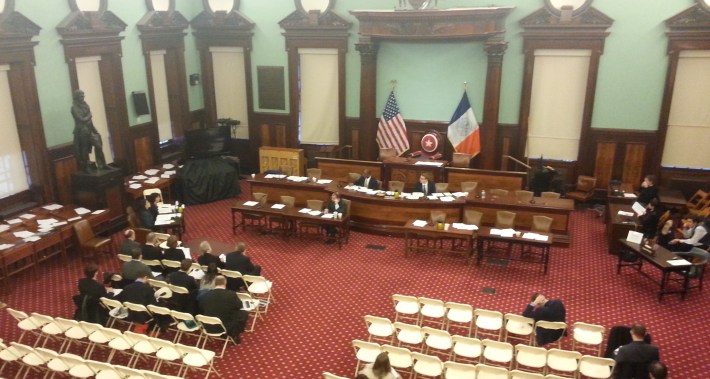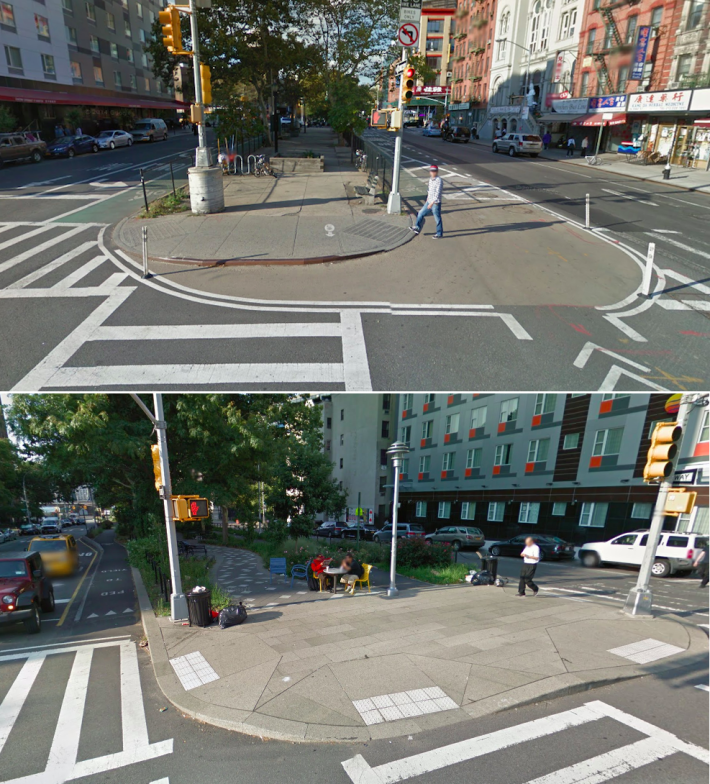
Before a City Council transportation committee budget hearing this morning, the de Blasio administration announced its "Great Streets" initiative, which includes $250 million in capital funds to improve safety on Queens Boulevard, the Grand Concourse, Atlantic Avenue, and Fourth Avenue in Brooklyn.
From 2009 to 2013, 34 pedestrians were killed and 215 seriously injured on these four arterial streets. Significant expansions of space for walking and biking on these streets will show that the de Blasio administration is willing to take on the toughest street design challenges.
Still unclear, however, is DOT's budgetary commitment to less expensive but still effective treatments like painted sidewalk extensions and parking-protected bike lanes, which can quickly extend safer designs to more neighborhoods and reduce traffic deaths and injuries on a more aggressive timetable.
The $250 million in capital funding will be spent over several years. Transportation Commissioner Polly Trottenberg said the bulk of the $100 million budgeted for Queens Boulevard, for example, would be spent in fiscal year 2018. The price is high because the streets will be reconstructed with new curbs and concrete.
DOT is also looking at bus lanes and protected bike lanes for these streets, but said final decisions will come after a community consultation process. Capital projects already in the pipeline for Fourth Avenue, however, would cast in concrete a design without protected bike infrastructure.
"This is going to be a very big initiative for us," Trottenberg said. "We're prepared to think as big as money and community support and the practicality of implementing will allow."
DOT has begun hosting meetings along Queens Boulevard, and has launched a similar process for Linden Boulevard in Brooklyn, which is not part of the Great Streets program.
"What we're going to see in the coming months is how aggressive the DOT is going to be with these new treatments," said Transportation Alternatives Executive Director Paul Steely White. "We advocates have to remain vigilant to make sure that this money is going to be spent in a way that is going to save the maximum number of lives."
DOT says it will fast-track the reconstruction of these four arterials through close coordination with the Department of Design and Construction and utility companies. Trottenberg said DOT and DDC have already trimmed project delivery time elsewhere by speeding up schedules in the Bronx and Staten Island, and hopes to cast concrete for the Great Streets program by 2017.
The agency will begin to implement short-term changes on these four streets as soon as this year, adding curb extensions, changing signal timing, and using paint and flexible posts to change street geometry.

These types of changes cost far less per mile than full street reconstruction and could prevent more crashes per dollar. But it's not clear how much DOT is ramping up its commitment to these types of quicker improvements.
So far, as part of its Vision Zero program, DOT has committed to 50 street safety projects each year -- ranging from a single intersection to full corridors. TA is asking DOT to double this output, which it estimates would cost an additional $50 million to $80 million annually.
"In our expense budget, we have additional Vision Zero funds that can go for a lot of these types of things," Trottenberg said. While these projects don't involve major capital dollars, they do require manpower if DOT staff negotiate with community boards. On some projects, DOT ends up returning to the same board several times, and the agency often gets rebuffed for absurd reasons.
"We haven't seen state-of-the-art safety fixes applied yet, and I think part of that has to do with the deference that the DOT is still giving to naysayers on local community boards. We need to take these safety fixes out of the realm of negotiation," White said. "They are simply part of modern street design, and they shouldn't be negotiated or watered down."
The cost of community outreach came up multiple times during today's hearing, including after Public Advocate Letitia James pushed DOT to make all bike lanes protected bike lanes.
In response, Trottenberg said that these types of designs require lots of consultation with merchants and community boards, and later reiterated DOT's commitment to adding 50 miles of bike lanes each year, including five miles of protected bike lanes annually. “That takes a lot of work," Trottenberg said. "I don’t want people to think that’s a small number."
"I know," said Council Member Antonio Reynoso. "Community boards are tough."
Other highlights from today's hearing:
- The budget includes $84 million in capital funding for Select Bus Service, which Trottenberg said would first be spent on Utica Avenue and Woodhaven Boulevard. DOT has applied for a $3 million Federal Transit Administration grant for final design work on Woodhaven SBS, and anticipates hearing a decision from the feds in August.
- Council Members I. Daneek Miller and Jumaane Williams were decidely Select Bus Service skeptics. Miller said Flushing-Jamaica SBS doesn't serve the community's needs and asked DOT if funds slated for the project could instead go to something else, while Williams said he's received complaints that bus lanes are causing traffic back-ups on Rogers Avenue and aren't worth the reduced travel times for bus riders. "We haven't really had a lot of calls to get rid of them," Trottenberg said of bus lanes. “Overall, they’ve been pretty successful for bus riders.”
- Council Member Elizabeth Crowley said she was "bothered" to see a bus driver arrested for violating the Right-of-Way Law after running over a teenager in a crosswalk, and Council Member Mark Weprin defended the law while urging more sensitive enforcement. Later, Reynoso vigorously opposed a bill from Miller to exempt bus drivers from the law. “The pedestrian was at no fault in what happened here," he said. "I think the Right-of-Way Law is fine as it is.”
- Trottenberg said that Cemusa, which has the city's street furniture contract, has provided 50 bus shelter ads and three newsstand advertisements for Vision Zero. Rodriguez noted that the city needs to engage in a broad education campaign on par with smoking cessation efforts.





